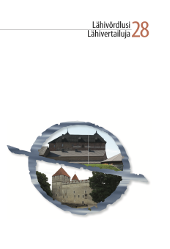Yhteistyön mahdollisuudet – lukiokoulutukseen valmistava koulutus kielellistyvässä maailmassa
Possibilities for co-operation: Preparatory training for general upper secondary education in a languagised world
Author(s): Heidi VaaralaSubject(s): Language studies, Education, Foreign languages learning
Published by: Eesti Rakenduslingvistika Ühing (ERÜ)
Keywords: preparatory education; General Upper Secondary Education; curriculum; monolingual norm; translanguaging; multilingual pedagogy; Finnish as a second language;
Summary/Abstract: This article examines the possibilities and obstacles there are for collaboration between the students of preparatory training for upper secondary education and the students of upper secondary school. Additionally, this article discusses how the students, teachers and principals describe the possibilities for translanguaging in preparatory training. In Finland, the National Core Curriculum for Preparatory Training for General Upper Secondary Education was set out for the first time in 2014. Te responsible body for this curriculum is the Finnish National Agency for Education. Te curriculum is intended for immigrants and foreign-language speakers, rather than other student groups such as Finns with learning difficulties (e.g. the preparatory students are separated from the non-preparatory students, but in the same school). Te objective of the education is to provide young and adult immigrants with linguistic and other capabilities to transfer to general upper secondary education. Te preparatory education syllabus must be completed in 1-2 years and it contains studies in Finnish/Swedish language, in another language where necessary, studies in the student’s own language, subjects included in the general upper secondary education syllabus, and the skills and knowledge required to study in a general upper secondary school. Te curriculum also includes guidance counselling and one of its aims is to increase the students’ knowledge of Finnish society and culture. This article is based on the theory of usage-based language acquisition, which posits that the most important component of language learning is the interaction and usage of the language. Te central concept of the article is translanguaging, which is seen as an opposite to the monolingual norm. Recent research-based discussion on the monolingual norm and multilingual practices can also be found in this article. Te method of this research is based on linguistic ethnography. Te data consists of interviews with principals, teachers and students of the preparatory class in one school over two years. Video recordings of classroom practices and feld notes were also utilized. In contrast to the government’s intentions, the principals do not feel that the preparatory training should only be available to immigrants. The principals point out that the integration of the two schools could be positive for language learning. Despite championing co-operation between the preparatory and nonpreparatory students, the principals describe co-operation through activities such as joint celebrations of national holidays, rather than fully integrated education. Te teachers admit that interaction between students is very important, and claim they can notice if a preparatory student has Finnish-speaking contacts. In spite of this belief, the data reveals there is a lot of teacher talk during the lessons, and that the students are mainly listening to the Finnish of the teacher without the possibility of interaction in Finnish or in any other language. Te analysis of the student practices shows that at home it is possible to make use of translanguaging and that using the student’s own language makes it possible to learn science more effectively. Te following of the monolingual norm hinders learning to some extent. Te students also express the wish to have friends outside their own class, while still acknowledging the multilingual and multicultural power of their own class. In the curriculum, it is stated that education should encourage interaction between various cultural groups and “the original population” and promote good ethnic relations. Furthermore, the curriculum must include co-operation and participation in the general upper secondary school’s activities. This article shows that the students, due to the lack of collaboration in their class and with the other secondary school students, are not able to use large parts of their language repertoires, and that the fact that they live in a languagised world is only partly considered in preparatory training. Te main research finding is that the students only have limited interaction with the other Finnish speaking students in the school. In addition, the classroom usage of languages follows the monolingual norm. As such, the aims of the language learning cannot be fully realized. It is obvious that more teacher training is needed in both the theory and the practice of second language learning, for both language-specific and subject-specific teachers. Te surrounding society has to be taken into consideration as an important part of language learning.
Journal: Lähivőrdlusi. Lähivertailuja
- Issue Year: 2018
- Issue No: 28
- Page Range: 357-391
- Page Count: 35
- Language: Finnish

